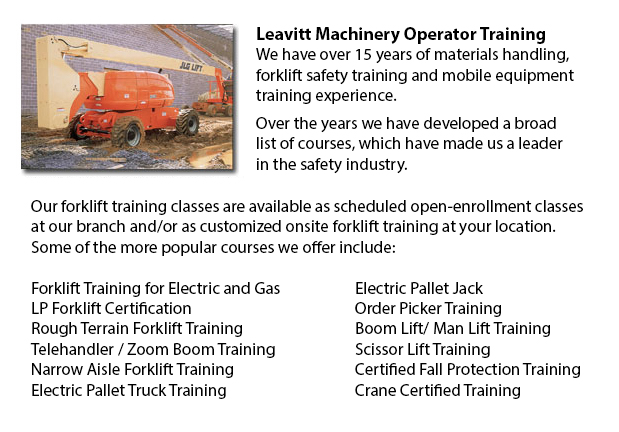
Boom Lift Certification Mississauga - Elevated work platforms allow work and maintenance operations to be performed at heights that can not be reached by whatever other way. Workers using scissor lifts and boom lifts could be taught how to safely operate these equipments by acquiring boom lift certification training.
When work platforms are operated unsafely, they have the possibility for serious injury and even death, regardless of their lift style, site conditions or application. Electrocution, falls, crushed body parts, and tip-overs could be the tragic result of incorrect operating procedures.
To avoid aerial lift incidents, individuals must be qualified to train workers in operating the particular type of aerial lift they would be utilizing. Controls must be easily accessible in or beside the platform of boom lifts used for carrying workers. Aerial lifts should never be modified without the express permission of the manufacturer or other recognized entity. If you are leasing a lift, ensure that it is maintained correctly. Prior to using, safety devices and controls should be checked to ensure they are working properly.
It is vital to follow safe operating procedures to be able to avoid workplace accidents. Driving an aerial lift while the lift is extended should not be done, however, a few models are designed to be driven when the lift is extended. Always set brakes. Set outriggers, if available. Avoid slopes, but when necessary use wheel chocks on slopes that do not go over the manufacturer's slope restrictions. Adhere to manufacturer's load and weight limitations. When standing on the platform of boom lifts, utilize full-body harnesses or a safety belt with a two-foot lanyard tied to the basket or boom. Fall protection is not needed for scissor lifts that have guardrails. Do not climb or sit on guardrails.
The boom lift certification course provides instruction in the following areas: safety tips to be able to prevent a tip-over; training and certification; slopes and surface conditions; checking the work area & travel path; stability factors; other tips for maintaining stability; leverage; weight capacity; pre-operational check; testing control functions; mounting a motor vehicle; safe operating practices; power lines and overhead obstacles; safe driving procedures; PPE and fall protection; making use of harnesses and lanyards; and avoiding falls from the platform.
The successful trainee will become familiar with the following: training and authorization procedures; pre-operational check procedures; how to avoid tip-overs; factors affecting the stability of scissor and boom lifts; how to use PPE, how to utilize the testing control functions and strategies in order to prevent falls.
-
Forklift Certification Courses Mississauga
Forklift Certification Courses Mississauga - Forklift certification courses really help to be able to make certain that businesses operating forklifts, follow the local and regional rules. The operators of the forklift must go through forklift certif... More -
Heavy Equipment Certification Mississauga
Heavy Equipment Certification Mississauga - Big pieces of machinery and heavy-duty vehicles are often referred to as heavy equipment. This broad term covers utility vehicles from agricultural and forestry implements to construction equipment, civil e... More -
Skid Steer Loader Training in Mississauga
The engine powered skid-steer loader has a rigid and small frame, outfitted together with lift arms that can attach to lots of industrial attachments and tools to perform numerous labor saving tasks. Usually, skid-steer loaders are four-wheel drive v... More -
Bucket Truck Training Mississauga
Bucket Truck Training Mississauga - The Vehicle-Mounted Aerial Work Platform or bucket truck training program is designed to decrease the possibility of incident and personal injury when working with or in close proximity to bucket trucks by efficien... More -
Scissor Lift Certification Mississauga
Scissor Lift Certification Mississauga - Scissor lift platforms are used at work locations to enable tradespeople - like for example welders, masons and iron workers - to reach their work. Utilizing a scissor lift platform is typically secondary to t... More -
Order Picker License Mississauga
Order Picker License Mississauga - Order preparation operation or order picking as it is more normally known is a process used within warehouse operations and comprises personnel called order pickers. The order picker's job is to take and collect art... More -
Forklift Train The Trainer Mississauga
Forklift Train The Trainer Mississauga - Our company provides the most advanced and latest Forklift Training courses in North America. We provide industrial workplace safety training, Train the Trainer, mobile equipment operator, and self study train... More -
Aerial Platform Training Mississauga
Aerial Platform Training Mississauga - Aerial forklifts are able to accommodate numerous odd jobs involving high and tricky reaching spaces. Normally utilized to execute daily maintenance in buildings with tall ceilings, trim tree branches, hoist hea... More

Forklift Training Mississauga
TOLL FREE: 1-888-254-6157
Mississauga, Ontario
forklifttrainingmississauga.ca
Email Us
About Us


